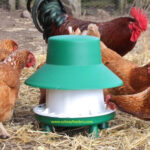Your basket is currently empty!
Crow & Magpie Traps
Controlling crow and magpie populations is essential in various environments to prevent damage to crops, protect other bird species, and manage nuisance behaviour.
Employing effective traps and strategies can help mitigate these issues effectively.
Larsen traps: Larsen traps are commonly used for catching crows and magpies. They consist of a compartment with a decoy bird and a separate catching compartment. When a corvid enters the trap to investigate the decoy, it triggers a mechanism that closes the catching compartment.
Cage traps: Cage traps are another option for capturing crows and magpies. Baited with food, these traps lure birds inside, and once they enter, the door closes behind them, trapping them inside.
Decoy Techniques:
Decoy birds: Placing decoy birds such as fake crows or magpies near traps can attract real birds to investigate, increasing the likelihood of trapping them.
Audio decoys: Playing recordings of distress calls or alarm calls of crows and magpies can deter them from an area or attract them towards traps.
Scare Tactics:
Visual deterrents: Scarecrows, reflective materials, and predator silhouettes can all deter crows and magpies from entering specific areas.
Sonic deterrents: Ultrasonic devices or sound emitters that produce distress calls or predator noises can startle crows and magpies, encouraging them to leave the area.
Legal Considerations:
Before employing any trapping or deterrent methods, it’s crucial to check local regulations and obtain any necessary permits for trapping corvids.
Some jurisdictions may have restrictions on the types of traps or techniques that can be used, as well as guidelines for humane treatment of trapped birds.
By combining various trapping methods, decoy techniques, and scare tactics, it’s possible to effectively control crow and magpie populations while minimizing harm to other wildlife and maintaining ecological balance. Additionally, staying informed about local regulations and ethical considerations ensures that control efforts are conducted responsibly and legally.
 Poultry & Game Feeders
Poultry & Game Feeders Poultry & Game Drinkers
Poultry & Game Drinkers Housing, Incubation & Brooders
Housing, Incubation & Brooders Vermin Control, Lamps & Torches, Batteries & Chargers
Vermin Control, Lamps & Torches, Batteries & Chargers Gamekeeping Accessories
Gamekeeping Accessories Electric Fencing, Netting and Pen Construction
Electric Fencing, Netting and Pen Construction Plucking & Crowning Machines Processing & Wrapping
Plucking & Crowning Machines Processing & Wrapping Health, Hygiene & Bird ID
Health, Hygiene & Bird ID Pigeons
Pigeons Footwear and Clothing
Footwear and Clothing Special offers
Special offers